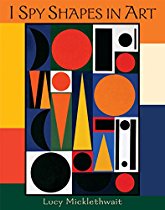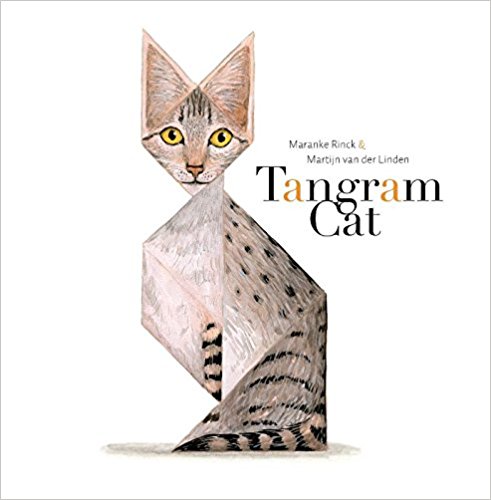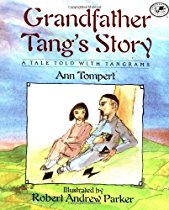Preschool Read a Loud Shapes, Size Numbers
Geometry Read Alouds
Practise you have a favorite geometry read aloud that yous like to utilise to build students' groundwork knowledge and vocabulary? We've reviewed some of those we use most often beneath. Choose one to launch your next geometry unit, or lesson, and download one of our follow upwards activities to provide opportunities for students to explore geometry concepts in meaningful ways.

![]()
Changes, Changes by Pat Hutchins
This wordless picture volume portrays the adventures of two small wooden figurines equally they arrange and rearrange a set of colored blocks to create what they need for unlike situations. The bright and colorful illustrations provide a wonderful opportunity for immature children to interpret the scenes and create their own dialogue as they come across how the same gear up of blocks can be used to make many different things. Worthy of display in all classroom block areas to provide inspiration for young builders, use in conjunction with this math center activeness to provide opportunities for students to see how 3-dimensional shapes can be composed to make new shapes (CCSS 1.G.A.two).

![]()
The Shape of Things by Dayle Ann Dodds (Writer) and Julie Lacome (Illustrator)
This rhyming text with simple, bright illustrations reveals how flat shapes are parts of things nosotros meet every day. "A foursquare is just a square, / Until y'all add a roof, / 2 windows and a door, / Then it's much, much more!" The verse and a square appear on one half of the two-page spread; a simple house appears on the other one-half. In like fashion, on other pages, a circumvolve becomes a Ferris cycle, ii triangles become a gunkhole, a group of rectangles get a train, and and then on. Use this geometry read aloud to get young children thinking and talking nigh shapes in their everyday lives.

![]()
I Spy Shapes in Art by Lucy Micklethwait
Based on the "I spy with my piffling eye" game Micklethwait encourages young readers to find shapes in famous paintings from a range of nineteenth and twentieth century artists, including Georgia O'Keeffe, Henri Matisse, Chiliad. C. Escher, and Andy Warhol. Each of the fourteen painting contains a unlike shape to find, some of which are easy to spot and others which are more than challenging. The colorful, clean design coupled with a big font and simple text ("I spy with my little eye a rectangle.") makes this a volume that early readers can enjoy independently after a whole class introduction.
When reading this book aloud we like to use the added phrase on the terminal page, "What do you spy?", throughout the book to encourage children to examine each painting closely. A lovely book for introducing fine art to young children while concurrently developing skills in recognizing and correctly naming shapes regardless of their orientations or size (CCSS Grand.G.A.2) . Afterward reading have students create their own works of art and "I spy" riddles based on a shape of their choosing.

![]()
Mouse Shapes by Ellen Stoll Walsh
Chased by a cat three mice hibernate in a pile of shapes. Once the threat subsides they use the shapes to make an assortment of things including a business firm, a tree, a wagon, and a fish. But when the cat returns the mice utilise the shapes to scare it away by creating "three large scary mice." Merely as visually highly-seasoned every bit Mouse Paint and Mouse Count, the simplicity of this book with its brightly colored pictures makes it an effective and fun introduction to shapes. Also available in Spanish (Las figuras de los ratones), this geometry read aloud deserves a identify in all preschool – 1st grade math libraries. After a course read aloud follow up with this easily on action to provide opportunities for students to come across how two-dimensional shapes tin can be composed to make new shapes (CCSS one.G.A.two).

![]()
Tangram True cat past Maranke Rinck & Martijn van der Linden
Tangram Cat is an amusing story about a male child who uses seven tangram pieces to create an imaginary cat . When the true cat feels lonely the boy tries to create a friend for it and an hazard begins as a procession of animals chase after each other. All of the delightful illustrations in this volume are fabricated out of the seven tans. The constantly changing configurations add together a novel touch to this geometry read aloud and provide a perfect introduction to the wonders of the tangram puzzle for younger readers. Opportunities for discussions most the properties of 2D shapes are plentiful and readers can create their own animals using the tangram pieces included on the final page.

![]()
Gramps Tang's Story by Ann Tompert (Author) and Robert Andrew Parker (Illustrator)
When Little Soo asks Grandfather Tang for a story he arranges the pieces of a tangram and two magic fox fairies spring to life, trying to outdo each other. The offset one becomes a rabbit, the other a dog who chases him, and and so on, until a hunter's arrow reminds them of their truthful friendship. This story provides an engaging introduction to a geometry lesson. Post-obit a class reading of this story we like to accept students work with tangram sets to create and record their own models of the book's characters. This activity is extended for older students by request them to look at the "parts" of the "whole" animal and determine the fractional part of each tangram piece if the small triangles have a value of 1. Changing the value of the whole takes things a pace further (e.g. If the large triangles have a value of ane one-half, how volition the value of each piece alter?)

![]()
The Greedy Triangle by Marilyn Burns (Author) and Gordon Silveria (Illustrator)
A busy triangle becomes dissatisfied with its life and asks a shapeshifter for ane more side and 1 more than angle. Transformed into a quadrilateral the triangle is happy for a while, but again and over again returns to the shapeshifter asking for just one more than side and one more than angle. When its many sides and angles are so minor that it becomes difficult to balance, the shape returns to the shapeshifter and asks to exist become a triangle once again.
This book provides an opportunity to innovate, or review, the names of different polygons (e.one thousand. quadrilateral, pentagon, hexagon, heptagon, octagon, nonagon, decagon) and when reading the story aloud we oft ask children to predict what the next shape will be. The illustrations of the shapes in dissimilar forms, places, and orientations provide farther data nigh the properties of shapes and how they are used. A popular geometry read aloud that we've used across a range of 2nd - 4th course classrooms in conjunction with this follow up activity .

![]()
The Wing on the Ceiling by Dr. Julie Glass (writer) and Richard Walz (Illustrator)
The coordinate system we normally employ, the Cartesian Coordinate System, was adult in the 17th century by the French mathematician and philosopher René Descartes. Based on one of math'south myths, this math reader describes how a very untidy Descartes invented this ingenious system in society to go along track of his possessions after wondering how all-time to describe a fly'south location on the ceiling. A lite hearted and accessible geometry read aloud that can exist used to launch a unit, or lesson on graphing points on the coordinate airplane (CCSS 5.G.A.1 and five.M.A.2).
More than Geometry Read Alouds
Amazon Assembly Disclosure
One thousand-5mathteachingresources.com is a participant in the Amazon Services LLC Assembly Plan, an affiliate advertising program designed to provide a means for sites to earn advertizement fees by ad and linking to Amazon.com
Source: https://www.k-5mathteachingresources.com/geometry-read-aloud.html
0 Response to "Preschool Read a Loud Shapes, Size Numbers"
Postar um comentário